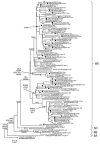Oseltamivir-resistant influenza A(H1N1)pdm09 viruses, United States, 2013-14
- PMID: 25532050
- PMCID: PMC4285251
- DOI: 10.3201/eid2101.141006
Oseltamivir-resistant influenza A(H1N1)pdm09 viruses, United States, 2013-14
Abstract
We report characteristics of oseltamivir-resistant influenza A(H1N1)pdm09 viruses and patients infected with these viruses in the United States. During 2013-14, fifty-nine (1.2%) of 4,968 analyzed US influenza A(H1N1)pdm09 viruses had the H275Y oseltamivir resistance-conferring neuraminidase substitution. Our results emphasize the need for local surveillance for neuraminidase inhibitor susceptibility among circulating influenza viruses.
Figures


References
-
- Centers for Disease Control and Prevention. Seasonal influenza activity and surveillance [cited 2014 May 21]. http://www.cdc.gov/flu/weekly/
MeSH terms
Substances
LinkOut - more resources
Full Text Sources
Other Literature Sources
Medical

